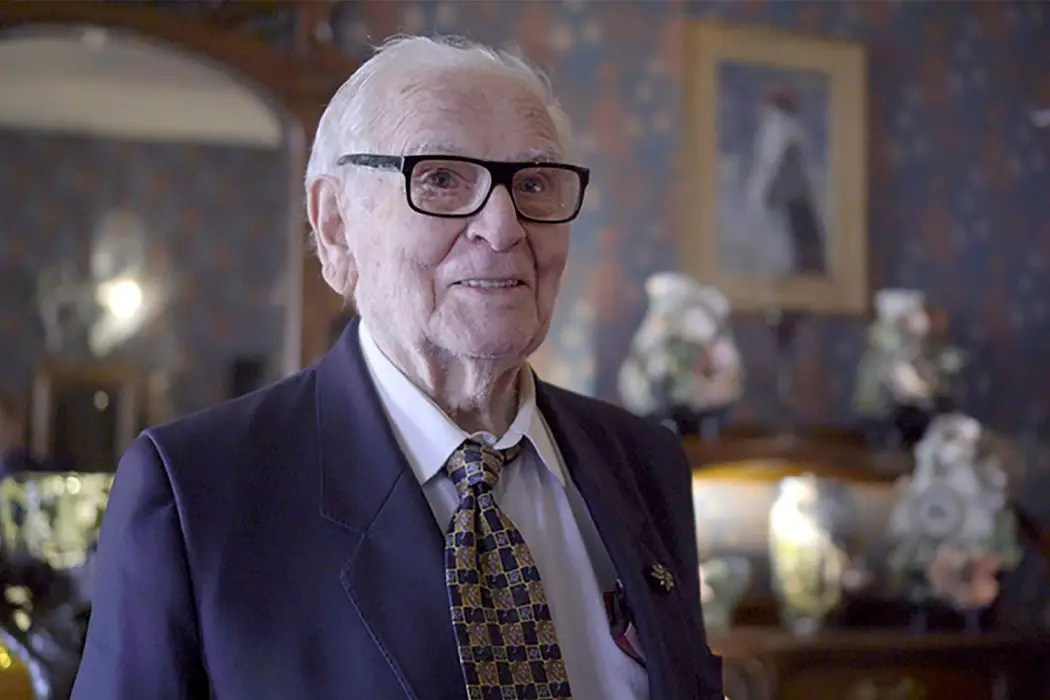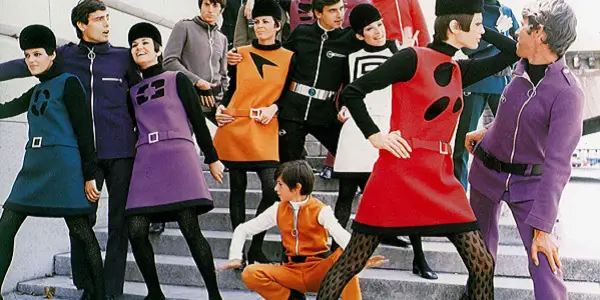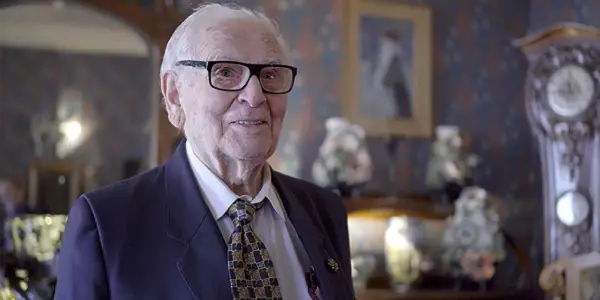HOUSE OF CARDIN: How One Man Became An Empire

Lee Jutton has directed short films starring a killer toaster,…
The name of Pierre Cardin is renowned as one of the most iconic fashion and lifestyle brands in the world, bringing futuristic style and avant-garde shape to everything from fashion to furniture. Not content to merely set trends with his designs, Cardin also broke barriers in regards to making high fashion more accessible and runways more diverse. All of these are accomplishments one can be proud of, but Cardin is not done yet: at age 97, he’s still active at the fashion house that bears his name.
The documentary House of Cardin, directed by P. David Ebersole and Todd Hughes, chronicles Cardin’s lengthy life and career and assesses his substantial legacy in the world of design. It’s a shiny, candy-colored look inside Cardin’s world, albeit one that is solely laudatory; if you’re looking for a critical examination of Cardin and his work, you’ll need to look elsewhere, because House of Cardin — authorized by the subject, who granted the filmmakers exclusive access — is content with a round of applause.
Origin Story
Cardin is famously tight-lipped about his private life, barely even acknowledging his high-profile romances with actress Jeanne Moreau and his longtime assistant André Oliver despite both essentially being public knowledge. However, for this film Cardin invited the filmmakers into his exclusive archives and granted them a series of interviews that are likely as intimate as we will ever get, providing a look back at a lengthy career that began in a tailor’s shop in Vichy before being sidetracked by a stop at the Red Cross in Paris during World War II.

After the war, Cardin worked with legendary designers such as Paquin, Schiaparelli, and Dior before founding his own house in 1950. Almost immediately, he began to shake up the stuffy world of Paris haute couture. When Cardin became the first couturier to launch a ready-to-wear collection for a department store, he was briefly expelled from the governing body of French fashion. Cardin viewed ready-to-wear as a market that could and should be tapped, but to many of his peers, democratizing high fashion lessened its value.
Born in Italy before moving to France as a teenager, Cardin also brought a global perspective to French fashion that helped modernize the industry. He traveled the world and brought his designs to Japan; he also brought the stunning Hiroko Matsumoto back to France with him as his top model, making her the first Japanese model to walk the Paris runways. He also brought his designs to markets such as China and Russia that, at the height of the Cold War, were decidedly ignored by the rest of the fashion world.
And that’s nothing to say for his designs, which alone were game-changing for the fashion industry. Cardin broke away from the form-fitting, perfectly tailored ensembles one associated with women’s fashion, preferring to focus on geometric shapes and experimental silhouettes. His most famous looks are less about showing off a woman’s figure and more about pure fun. Cardin fashion is synonymous with the Space Age era, and with good reason; many of his designs look straight out of an episode of The Jetsons, encompassing all of the hope, innovation, and adventure that midcentury Americans thought lay beyond the stars.

A Century of Creation
From a cynical perspective, it’s easy to chalk up some of Cardin’s most groundbreaking business decisions as just that: good business. When he proceeded to license the Cardin brand and slap his signature logo on everything from toasters to bottled water, some argued that he was watering down the Cardin name and everything it represented. And yet, with a fortune worth hundreds of millions that has enabled him to build dream houses, buy famous restaurants, and open his own theaters, it’s hard to argue now that Cardin’s decisions haven’t proved to be remarkably astute.
Even if the evidence were to the contrary, House of Cardin would not be the place to look for it. The film features a wide range of interviews covering Cardin’s personal and professional lives, including Cardin’s nephew and heir apparent Rodrigo Basilicati, model Naomi Campbell, songstress Dionne Warwick, and Cardin’s assistant turned fellow designer Jean-Paul Gautier. All speak in largely glowing terms on how Cardin has affected and influenced their lives and careers. There are numerous fun anecdotes to be heard from the terribly glamorous world of mid-twentieth-century Paris, including Warwick describing how Marlene Dietrich walked into her dressing room and told her she should only wear couture and Alice Cooper (yes, that one) describing the riots outside Cardin’s theater when he and his band came to perform.

When describing Cardin’s relationship with Oliver, who passed away from AIDS in 1993, the film takes its darkest and most soul-searching turn; listening to Cardin talk about him, Moreau, and other lifelong friends who he has now outlived is quite heartbreaking. But for the most part, House of Cardin functions as a glossy promotional video for the man and the brand at its heart. That isn’t to say it isn’t enjoyable, especially if you are already a fan of Cardin and the period of history when he was at his heyday. Just don’t expect anything harder hitting than a Cardin-branded pillow.
House of Cardin: Conclusion
House of Cardin encapsulates how one man became an empire, one that continues to thrive even as he approaches a century of life on this planet.
What do you think? Are you familiar with Pierre Cardin’s designs? What do you think is the most important piece of his legacy? Share your thoughts in the comments below.
House of Cardin had its NYC premiere at DOC NYC on November 9, 2019. You can find more international release dates here.
Does content like this matter to you?
Become a Member and support film journalism. Unlock access to all of Film Inquiry`s great articles. Join a community of like-minded readers who are passionate about cinema - get access to our private members Network, give back to independent filmmakers, and more.
Lee Jutton has directed short films starring a killer toaster, a killer Christmas tree, and a not-killer leopard. Her writing has appeared in publications such as Film School Rejects, Bitch: A Feminist Response to Pop Culture, Bitch Flicks, TV Fanatic, and Just Press Play. When not watching, making, or writing about films, she can usually be found on Twitter obsessing over soccer, BTS, and her cat.













